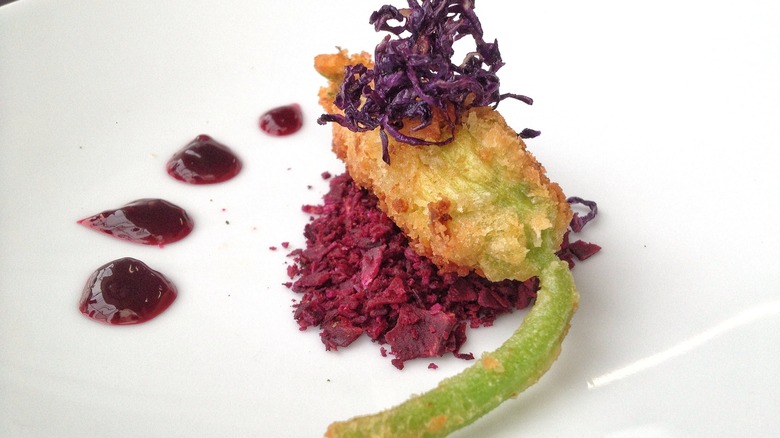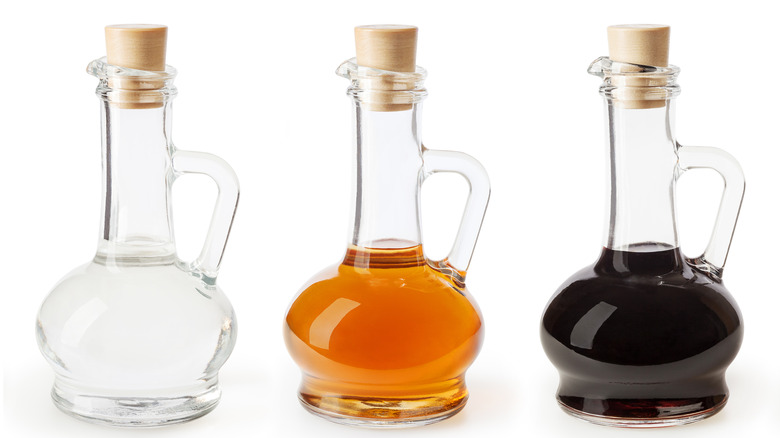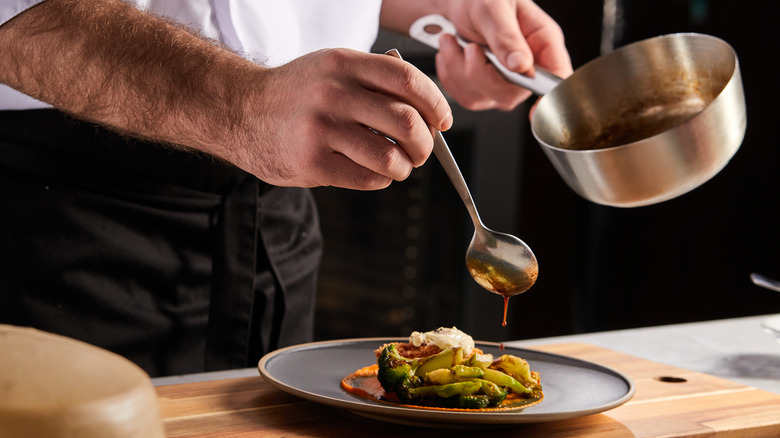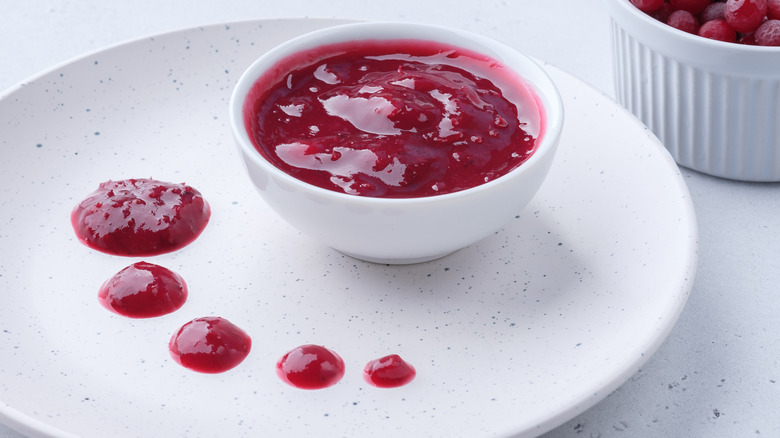What Is Gastrique And How Do You Serve It?
Watch any competitive cooking show, and it feels like you will hear the word gastrique mentioned numerous times. From halibut to filet mignon, a winning dish apparently must be served with a gastrique. But does this elegant-sounding sauce truly improve the dish, or does it make it sound fancier? The answer is both. Originating with French cuisine, a gastrique is a versatile sauce that can be used with a variety of proteins and can have many flavor profiles, depending on the ingredients. In its most basic form, a gastrique is a sauce that has been created by reducing sugar and vinegar over heat and can be described as a sweet and sour sauce.
The sweetness in the sauce generally comes from a fruit, while the tartness is derived from a vinegar. And from there, a cook can build on the flavors with citrus, herbs, fruits, and more. Taking about 30 minutes to make, this simple sauce adds flavor complexity to dishes, hence, making it a great addition to cooking challenges.
Sweet and sour ingredients
To make a simple gastrique sauce, only a few ingredients are required: unsalted butter, a shallot, fruit, sugar, wine or cognac, and vinegar. Plan on using 2 cups of fruit that have been peeled and cut into 1/2-inch slices if using larger fruit or 2 cups of whole berries. However, not all gastriques contain alcohol, nor do they all contain fruit, but they all do contain vinegar. A take on a gastrique for a steak from the James Beard Foundation calls for honey, Cabernet vinegar, and salt to taste.
What all gastriques do have is caramelization, whether it comes from fruit, honey, or another sweet element. Additionally, the vinegar plays a key role in crafting a gastrique, influencing its final flavor and what other ingredients can be used. If selecting a red wine vinegar, the flavor of raspberry or grape will be dominant and best paired with chicken, pork, or seafood. Cider vinegar, on the other hand, will have a sharper flavor and is compatible with spicy foods. Gastriques made with fruit tend to complement red meat dishes really well, but cider vinegar-based gastriques that are made with spicy components such as chiles and ground pepper are best served with white meats and poultry.
How to make gastrique
Making a gastrique is a rather simple process that starts with melting butter in a small saucepan and then adding minced shallots and cooking until translucent. It's at this point that the real customization of the gastrique can happen. Select from a variety of vinegars (such as balsamic versus white wine), fruits, and alcohol to create a flavor that complements the protein or vegetables you are making. Add the chosen fruit, sugar, wine or cognac, and vinegar to the pan containing the butter and shallots. The mixture can then be brought to a very light boil and reduce the heat to low. Continue to simmer until the fruit is very tender, and then either put through a sieve to remove seeds (if there are any) or put straight into a blender to purée. Season as you want and then serve.
Once made, a gastrique can be served right away, stored in the refrigerator for up to two weeks, or kept in the freezer for a longer period of time.
How to serve a gastrique
In general, use a light hand when drizzling a gastrique on a dish, as it often packs a lot of flavor. Making a fatty meat, such as duck or beef? Go with a boldly flavored gastrique, such as one made with cherries or blackberry. A lighter gastrique flavored with apple or mango tends to partner better with the flavors of light pork and poultry. Seafood dishes get a flavor boost from gastriques prepared with herbs or citrus flavors. It's best to serve gastrique warm with roasted or simmered meats and vegetables but allowed to cool before plating with cheese.
Gastriques aren't just for food, te can also add dynamic flavor to alcoholic beverages, such as a Bloody Mary. Other alcoholic beverages that work well with a gastrique are margaritas or any drink that can be made with a sweet-and-sour base where a sour mix is traditionally used.
Gastrique variations
There are many possible variations for gastrique. Use your imagination and taste buds to explore and have fun. Don't have cognac in your cabinet or want to use an expensive bottle of wine from the cellar? Supplement with flavored brandies, cooking wines, or vermouth. Use what fruit is in season or what is commonly used in a region's cuisine, such as apple, blood orange, peach, or berries in France. Combining compatible fruits and berries is also an option, as well as forgoing fruit and making a brandy gastrique instead.
Stock can also add flavor to a gastrique, whether beef, vegetable, or chicken. An apple cider gastrique can be prepared with chicken stock, as well as both apple cider and apple cider vinegar. Even consider elements of spice, such as chiles for a gastrique. Herbs, spices, and citrus peel can add a punch of flavor. If the sauce becomes too thin after these ingredient additions, it can be reduced over heat again and then served.
Even if you are not competing for a cooking prize, consider adding a gastrique to your next dinner to elevate your dish and please your taste buds.




